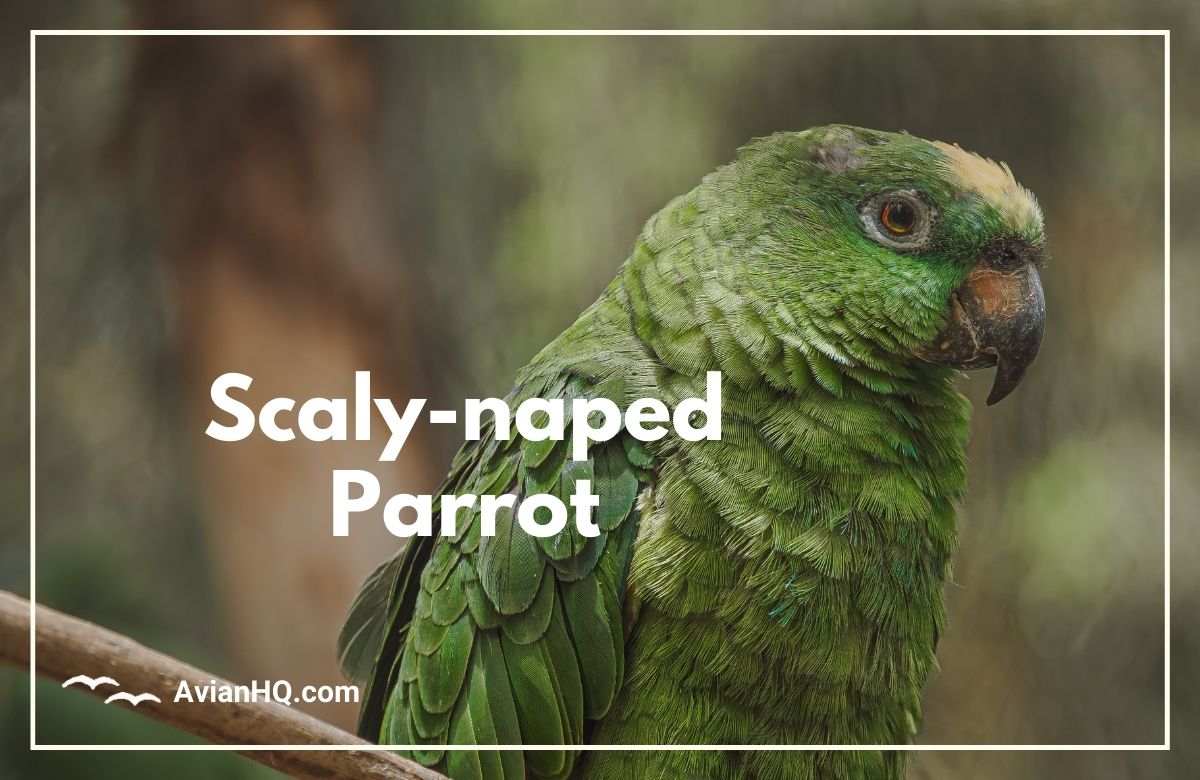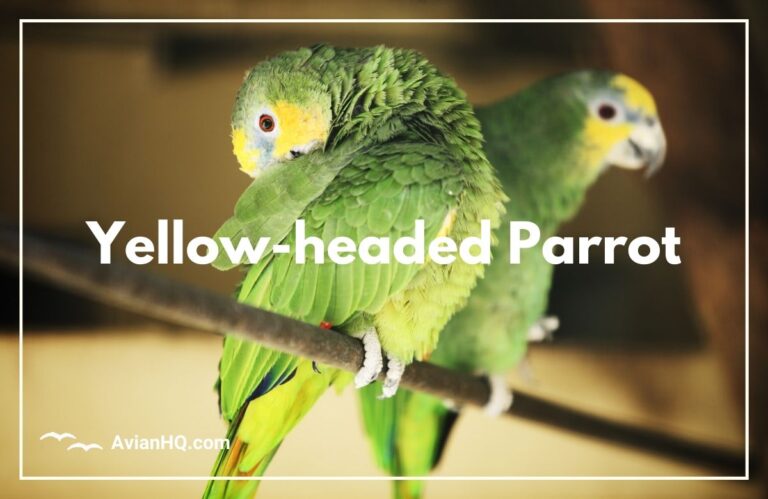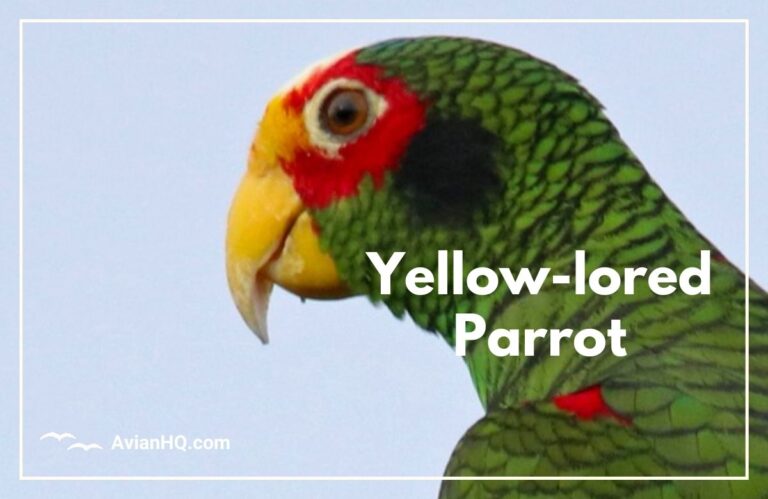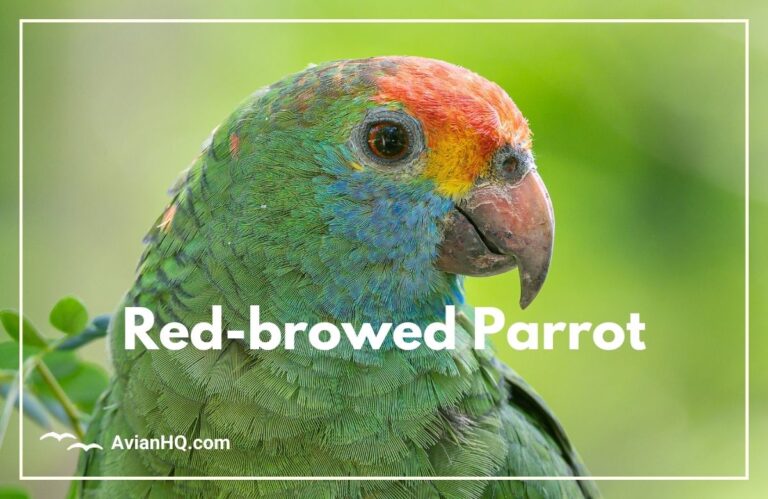Scaly-naped Amazon Parrot (Amazona mercenarius)
Have you ever seen a bright green parrot with a red and blue banded tail perched high in the treetops of a misty mountain forest? If so, you may have spotted the Scaly-naped Parrot, a shy and little-known amazon species found in the northern Andes Mountains of South America. These colorful birds stand out with their vibrant green plumage accented by vibrant red, blue, and yellow markings. Despite their striking appearance, Scaly-naped Parrots tend to avoid human contact, keeping to remote forests far from major cities and towns.
The Scaly-naped Amazon Parrot is known by several other common names, including the Mercenary Amazon, Tschudi’s Amazon, and Gray-naped Amazon. Its scientific name, Amazona mercenarius, comes from the Greek word amazōn referring to the legendary Amazons female warriors. The species name mercenarius is Latin for “mercenary soldier.” This may refer to the parrot’s bright red wing patches, resembling the red uniforms historically worn by European mercenary troops.
Two subspecies of Scaly-naped Parrots exist, each with their own distinct geographic range along the Andes. The nominate subspecies, A. m. mercenarius, occurs from Bolivia to Ecuador. The second subspecies, A. m. canipalliata, is found further north from Colombia to Venezuela. Read on to learn more about the identification, behavior, conservation status, and ecological role of this mountain parrot.
History and Taxonomy
The Scaly-naped Parrot was first described for science in 1844 by German-Swiss zoologist Johann Jakob von Tschudi. He collected a specimen in the Peruvian Andes which became the type specimen for the species. For nearly 80 years it was considered the only representative of the genus Amazona found in the South American highlands.
The scientific name Amazona mercenarius refers to several distinctive aspects of this parrot. The genus name Amazona recalls the legendary female warriors of Greek mythology. The species name mercenarius is Latin for “mercenary soldier,” possibly referring to the bright red patch on the wings resembling the uniforms of European mercenary troops.
Two subspecies of the Scaly-naped Parrot are recognized today based on differences in plumage and geographic distribution:
- A. m. mercenarius – The nominate subspecies occurring from Bolivia to Ecuador along the Andes. This is the original subspecies collected and named by Tschudi in 1844.
- A. m. canipalliata – Named in 1874, this northern subspecies is found from Colombia to Venezuela. It resembles A. m. mercenarius but has hidden maroon wing patches instead of bright red.
Physical Appearance
The Scaly-naped Parrot is a medium-sized amazon, reaching 13.2 inches (34 cm) in length. Their average weight is about 10.5 ounces (300 grams).
These parrots have bright green overall plumage, with a scaly black-edged appearance on the head and chest feathers. The wings have vivid red or maroon patches, depending on the subspecies. The tail is green with a wide yellow-green band, and the outer tail feathers are tipped or edged with blue and purple.
The differences between the two subspecies are subtle:
- A. m. mercenarius – Bright red wing patches at the base of the secondary feathers
- A. m. canipalliata – Hidden maroon markings instead of the bright red patches
Both subspecies have pale gray eye rings, vibrant red eyes, a grayish horn-colored bill, and gray to brownish legs.
Juvenile Scaly-naped Parrots resemble the adults but can be identified by their pale gray bill and brownish eyes. Their plumage is otherwise identical to the adults.
Habitat and Distribution
The Scaly-naped Parrot occupies a very specific mountain forest habitat along the Andes Mountains of South America. Its elevational range extends from 2,600 to 5,200 feet (800 to 1,600 meters) above sea level.
This species is found in Colombia, Venezuela, Ecuador, Peru, and Bolivia. It resides in tropical and subtropical moist montane forests, favoring misty, humid environments. Some key habitat features include:
- Hill and mountain forests with a mix of open and densely forested areas
- Cloud forests and paramo zones with wooded valleys and ravines
- Areas with large tall trees for roosting and nesting
Within their forested mountain habitat, the Scaly-naped Parrot is often the only amazon species present. They do not appear to have been introduced and established in any areas outside their native Andean range.
The nominate subspecies A. m. mercenarius occupies the southern portion of the range from Bolivia to Ecuador. The northern subspecies A. m. canipalliata resides from Colombia to Venezuela, with a small population in northwest Venezuela as well.
Diet and Feeding
In the wild, the Scaly-naped Parrot feeds on a variety of mountain forest fruits and some seeds. Their diet includes:
- Figs
- Other fruits like oranges and pomegranates
- Some reports indicate they may eat corn/maize as well
Very little quantitative data exists on the diet of these shy parrots. But observers have noted them feeding on figs and unidentified fruit in Colombia. Their fruit-heavy diet fits with typical feeding patterns seen in other amazon parrots.
These parrots exhibit social feeding behaviors, gathering in pairs or small flocks of less than 30 individuals. They follow a daily routine of leaving communal roost sites early in the morning and returning in the late afternoon before dusk. Their feeding activities take place during short intervals in the early morning and late afternoon hours.
Travelling to and from feeding sites, Scaly-naped Parrots may gather in larger flocks of 30-40 birds. But they ultimately disperse into smaller subgroups once they arrive to actual fruiting trees and shrubs to feed. Their shy and wary disposition prevents these birds from assembling in very large, conspicuous flocks out in the open.
Breeding and Reproduction
Relatively little is known about the breeding behaviors of the Scaly-naped Parrot since nests are difficult to access in remote mountain forests.
Observations indicate the breeding season lasts from March to May. Nests are located in tree cavities high up in large trees. The nest sites are often impossible for researchers to examine since these birds choose very tall, inaccessible locations.
Clutch size has not been firmly established. The few nests studied contained a small number of eggs, suggesting they may lay only 2-4 eggs. Their eggs are ovate (elongated) in shape, measuring approximately 1.4 inches x 1.1 inches (35.5 mm × 28.0 mm) in size.
Incubation lasts 25-26 days from the limited data available. The nestling phase where chicks are fed in the nest remains unreported. As with many parrots, the chicks likely fledge at 8-12 weeks of age but more study is needed on the full breeding chronology.
Behavior and Ecology
The Scaly-naped Parrot is often described as a very shy and wary species compared to other amazon parrots. They are usually found alone, in pairs, or in small flocks of less than 30 birds.
These parrots display some interesting social behaviors related to roosting and feeding. They gather in larger flocks at dawn and dusk to commute between communal roosting sites and feeding areas. But during the day, they break up into smaller subgroups that disperse widely in the forest to search for fruit.
As fruit becomes seasonally scarce, tensions may arise over prime feeding spots. But overall, these quiet parrots are not known to exhibit aggressive behaviors. Their interactions with other Amazona parrots are not well documented but likely limited since their range has little overlap with most other species.
Beyond these basics, much of the Scaly-naped Parrot’s behavior and ecology remains a mystery to science. Their inaccessible nesting habits and remote forest habitat make them a challenging species to study in depth. More research is needed to elucidate details on lifespan, migratory movements, breeding chronology, and other aspects of their natural history.
Conservation Status
The Scaly-naped Parrot is evaluated as Least Concern on the IUCN Red List of Threatened Species. However, there is evidence its population is decreasing gradually due to habitat loss.
Unfortunately, comprehensive surveys have not quantified the global population size for this species. Scientsts estimate numbers in the low thousands to tens of thousands, but more data is required. The birds do appear to be fairly common within suitable habitat through most of their Andean range.
Major threats to Scaly-naped Parrots stem from deforestation activities in the tropical Andes. Mining, logging, infrastructure development, and conversion for agriculture are destroying and degrading their specialized mountain forest ecosystem.
Given their shrinking habitat, potentially small overall population, and relative rarity in aviculture, the Scaly-naped Parrot merits more organized conservation measures. However, no special legal protections or management plans exist currently to monitor and safeguard populations in the wild. More research and habitat protections are crucial for ensuring the long-term survival of this shy mountain parrot.
Conclusion
The Scaly-naped Parrot is an elusive highland species that remains poorly understood by science. As a shy bird that shuns human presence, many aspects of its natural history have yet to be revealed through further study. But the vibrant green and red plumage of these parrots makes them a memorable sight for any lucky visitor to their remote Andean cloud forest habitat.
While still reasonably common locally, habitat loss and fragmentation have put Scaly-naped Parrot populations on a gradual decline. Logging, mining, agriculture, and other human activities continue to degrade and eliminate critical nesting and feeding areas for this specialist bird. Further research and strengthened legal protections of tropical montane forests are necessary to ensure the long-term survival of both subspecies across northern South America.
Trekking through the misty paramo or winding mountain valleys near the tree line, remain alert for a flash of green and red overhead. You may spot one of these furtive highland amazons perched silently above, camouflaged amid the bromeliads and orchids. But enjoy the sight while you can – the Scaly-naped Parrot may not remain a fixture of these Andean forests forever if conservation measures are not taken soon.







